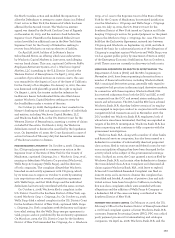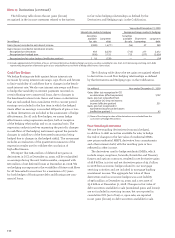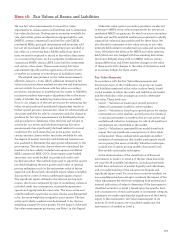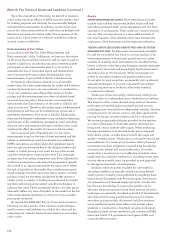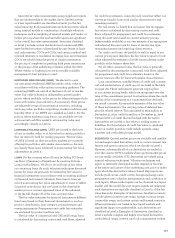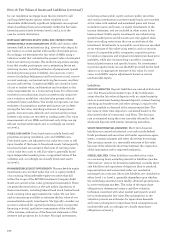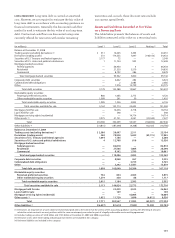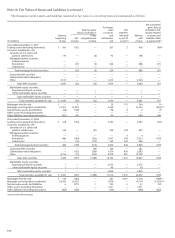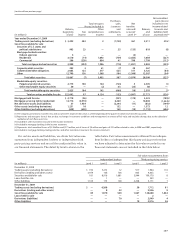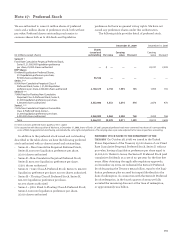Wells Fargo 2009 Annual Report Download - page 153
Download and view the complete annual report
Please find page 153 of the 2009 Wells Fargo annual report below. You can navigate through the pages in the report by either clicking on the pages listed below, or by using the keyword search tool below to find specific information within the annual report.
Note 16: Fair Values of Assets and Liabilities
We use fair value measurements to record fair value
adjustments to certain assets and liabilities and to determine
fair value disclosures. Trading assets, securities available for
sale, derivatives, prime residential mortgages held for sale
(MHFS), certain commercial loans held for sale (LHFS),
residential MSRs, principal investments and securities sold
but not yet purchased (short sale liabilities) are recorded at
fair value on a recurring basis. Additionally, from time to
time, we may be required to record at fair value other assets
on a nonrecurring basis, such as nonprime residential and
commercial MHFS, certain LHFS, loans held for investment
and certain other assets. These nonrecurring fair value
adjustments typically involve application of lower-of-cost-
or-market accounting or write-downs of individual assets.
We adopted new guidance on fair value measurements
effective January 1, 2009, which addresses measuring fair
value in situations where markets are inactive and transactions
are not orderly. In accordance with fair value accounting
provisions, transaction or quoted prices for assets or liabilities
in inactive markets may require adjustment due to the uncer-
tainty of whether the underlying transactions are orderly.
Prior to our adoption of the new provisions for measuring fair
value, we primarily used unadjusted independent vendor or
broker quoted prices to measure fair value for substantially all
securities available for sale. In connection with the change in
guidance for fair value measurement, we developed policies
and procedures to determine when the level and volume of
activity for our assets and liabilities requiring fair value
measurements has significantly declined relative to normal
conditions. For such items that use price quotes, such as
certain security classes within securities available for sale,
the degree of market inactivity and distressed transactions
was analyzed to determine the appropriate adjustment to the
price quotes. The security classes where we considered the
market to be less orderly included non-agency residential
MBS, commercial MBS, CDOs, home equity asset-backed
securities, auto asset-backed securities and credit card-
backed securities. The methodology used to adjust the quotes
involved weighting the price quotes and results of internal
pricing techniques such as the net present value of future
expected cash flows (with observable inputs, where available)
discounted at a rate of return market participants require.
The significant inputs utilized in the internal pricing tech-
niques, which were estimated by type of underlying collateral,
included credit loss assumptions, estimated prepayment
speeds and appropriate discount rates. The more active and
orderly markets for particular security classes were determined
to be, the more weighting assigned to price quotes. The less
active and orderly markets were determined to be, the less
weighting assigned to price quotes. For the impact of the new
fair value measurement provisions, see Note 1 in this Report.
Under fair value option accounting guidance, we elected
to measure MHFS at fair value prospectively for new prime
residential MHFS originations, for which an active secondary
market and readily available market prices existed to reliably
support fair value pricing models used for these loans. We
also elected to remeasure at fair value certain of our other
interests held related to residential loan sales and securitiza-
tions. We believe the election for MHFS and other interests
held (which are now hedged with free-standing derivatives
(economic hedges) along with our MSRs) reduces certain
timing differences and better matches changes in the value
of these assets with changes in the value of derivatives used
as economic hedges for these assets.
Fair Value Hierarchy
In accordance with the Fair Value Measurements and
Disclosures topic of the Codification, we group our assets
and liabilities measured at fair value in three levels, based
on the markets in which the assets and liabilities are traded
and the reliability of the assumptions used to determine
fair value. These levels are:
• Level 1 – Valuation is based upon quoted prices for
identical instruments traded in active markets.
• Level 2 – Valuation is based upon quoted prices for similar
instruments in active markets, quoted prices for identical
or similar instruments in markets that are not active, and
model-based valuation techniques for which all significant
assumptions are observable in the market.
• Level 3 – Valuation is generated from model-based tech-
niques that use significant assumptions not observable
in the market. These unobservable assumptions reflect
estimates of assumptions that market participants would
use in pricing the asset or liability. Valuation techniques
include use of option pricing models, discounted cash
flow models and similar techniques.
In the determination of the classification of financial
instruments in Level 2 or Level 3 of the fair value hierarchy,
we consider all available information, including observable
market data, indications of market liquidity and orderliness,
and our understanding of the valuation techniques and
significant inputs used. For securities in inactive markets, we
use a predetermined percentage to evaluate the impact of fair
value adjustments derived from weighting both external and
internal indications of value to determine if the instrument is
classified as Level 2 or Level 3. Based upon the specific facts
and circumstances of each instrument or instrument category,
judgments are made regarding the significance of the Level 3
inputs to the instruments’ fair value measurement in its
entirety. If Level 3 inputs are considered significant, the
instrument is classified as Level 3.






